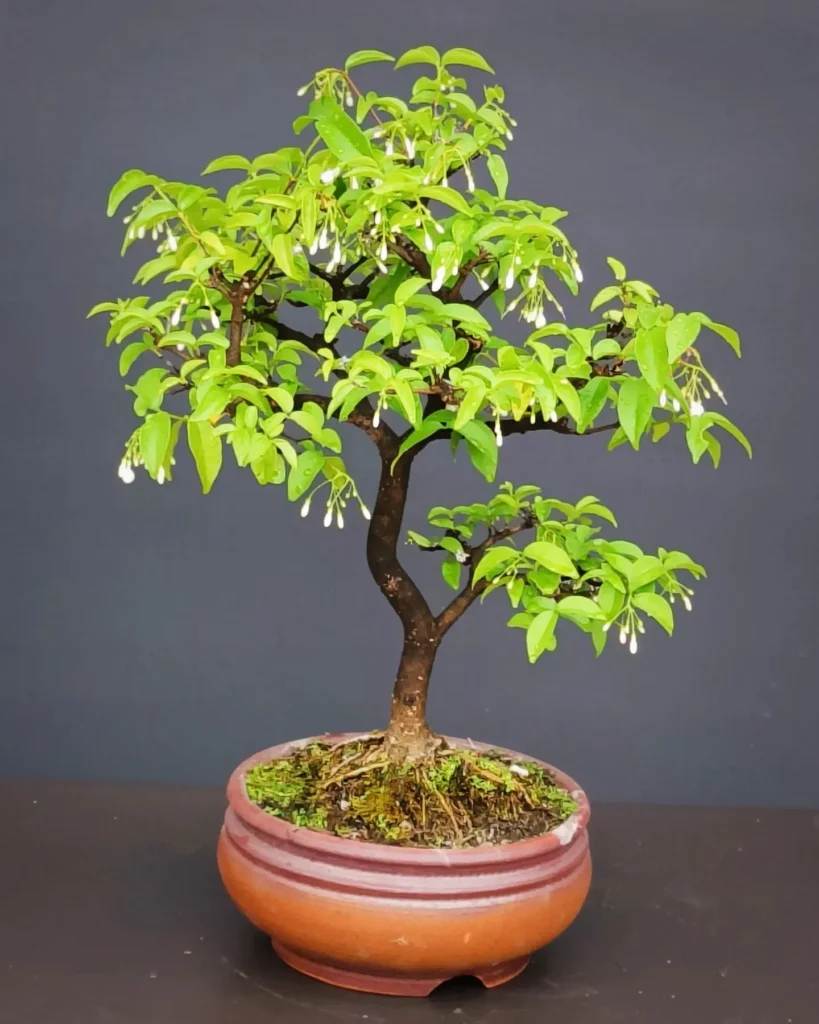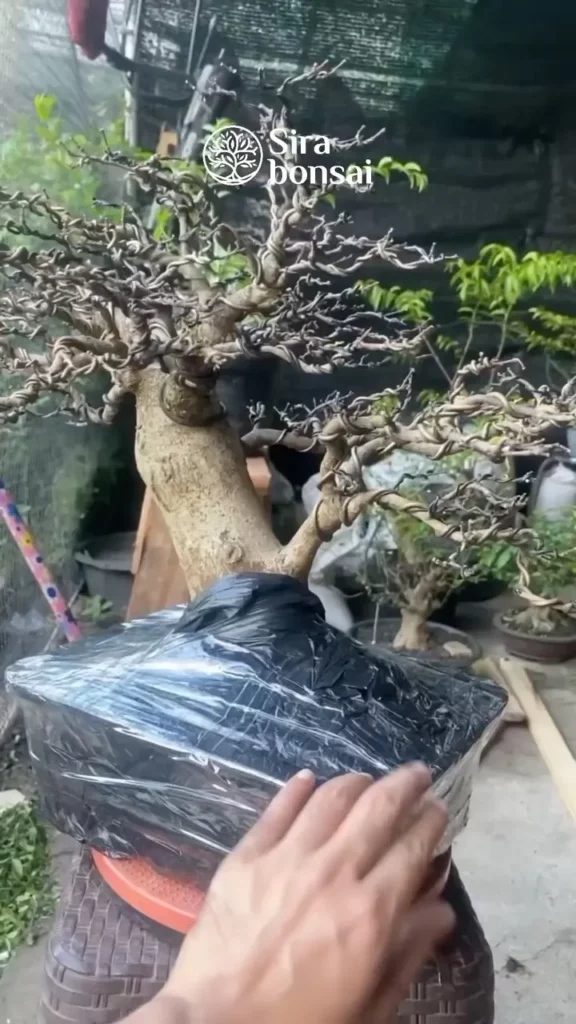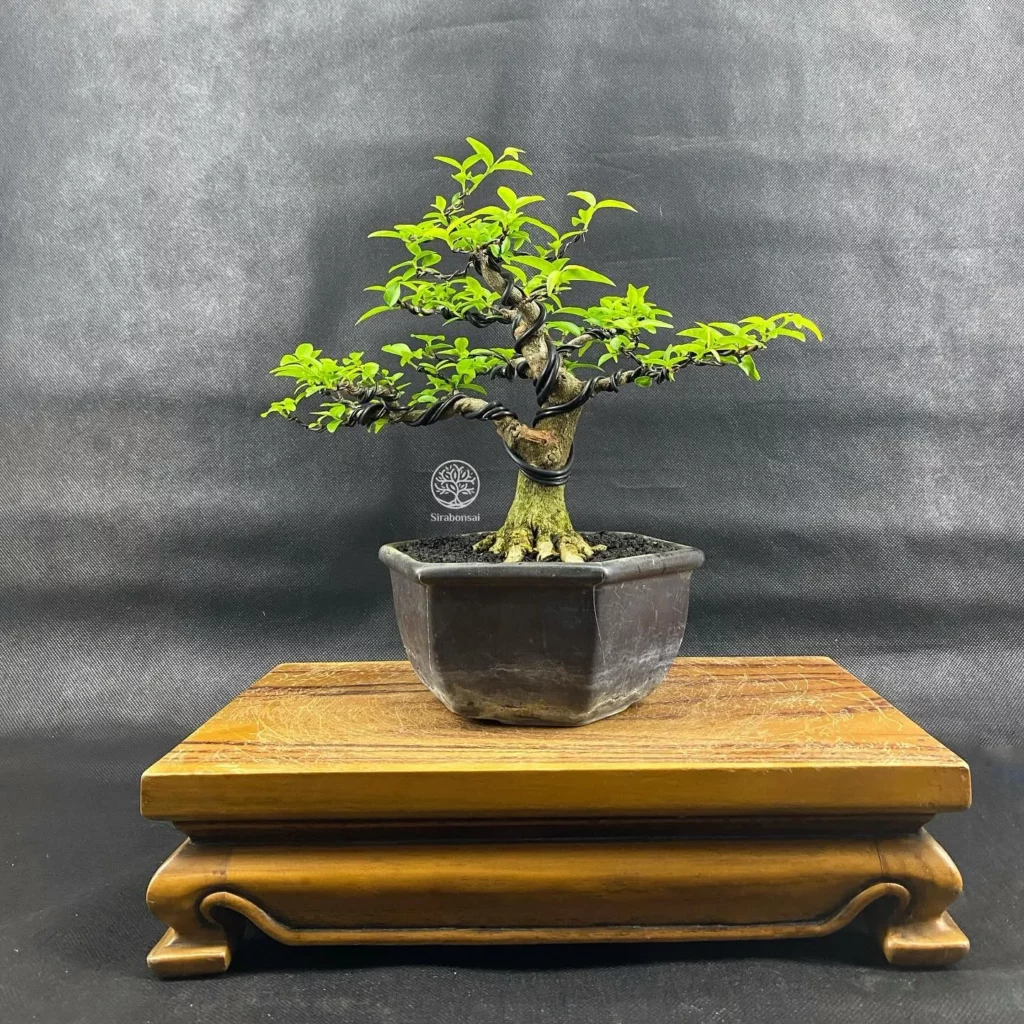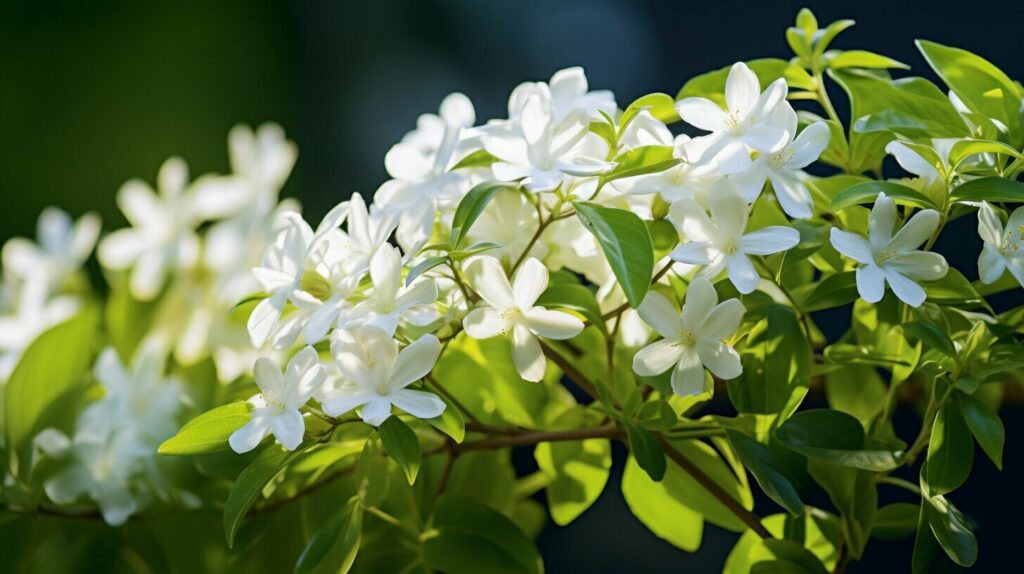The Water Jasmine Bonsai, also known as Wrightia Religiosa or Sacred Buddhist, is a popular choice among bonsai enthusiasts due to its beautiful and delicate white flowers that bloom throughout the year. The plant originated in Southeast Asia and India and requires special care to thrive as a bonsai.
Proper Care For Healthy Growth



Proper care is crucial in ensuring that your Water Jasmine Bonsai thrives, remains healthy, and lives long enough to be passed down through generations. A well-maintained bonsai will improve the aesthetic value of your home or garden while providing you with an enjoyable hobby.
The small size means it’s ideal for those living in apartments or townhouses, and it’s the perfect way to add some greenery to your living space. The plant also has a significant cultural significance in countries such as Thailand and India where it’s used in religious ceremonies.
Watering
Water is a crucial element in the life of Water Jasmine Bonsai trees, and therefore, watering is an essential aspect of their care. Getting the right amount of water at the appropriate frequency can make a significant difference in achieving healthy growth and longevity for your tree. As a general rule, you should not let your Water Jasmine Bonsai dry out completely or keep it too wet for an extended period.
Frequency And Amount Of Watering
The frequency and amount of watering necessary for your Water Jasmine Bonsai depend on several factors such as humidity levels, temperature, size of the pot or container, type of soil used, and more. As a general guideline, most bonsai enthusiasts recommend watering once every two to three days during summer months when temperatures are high. However, this may vary depending on environmental conditions.
Tips For Proper Watering Techniques
Here are some tips to help you water your Water Jasmine Bonsai correctly:
- Water only when the soil is slightly dry.
- Avoid watering during the hottest time of the day to prevent burning roots.
- Use a watering can or hose with a fine nozzle to avoid damaging leaves or branches.
- Ensure that water reaches all parts of the soil evenly but avoid creating water pools on the surface.
- Avoid using tap water if it has excessive minerals or chemicals that may harm your plant. Instead, use rainwater or distilled water for best results.
Humidity Levels



The amount of moisture in the air also plays a significant role in the health of your Water Jasmine Bonsai tree. These plants thrive in environments with high humidity levels that mimic their natural habitat. Therefore, if you live in an area with low humidity levels or have an indoor bonsai tree, you may need to take some extra steps to increase humidity.
You can achieve increased moisture levels by using a humidifier or placing pebbles at the bottom layer of a tray filled with water under your plant’s pot. This allows for evaporation that increases air moisture around your plant.
Soil And Fertilizer
The soil for your water jasmine bonsai needs to be well-draining, moisture-retentive, and aerated. The ideal soil mix for this plant should be composed of 60% inorganic matter such as perlite or vermiculite, 20% organic matter such as peat moss or composted bark, and 20% coarse sand.
This mixture is perfect for allowing the water to easily pass through while retaining the necessary moisture levels to keep your bonsai healthy. It is essential to note that the pH level of your soil should be between 6.0 and 7.5.
Fertilizers Suitable For Water Jasmine Bonsai
Water jasmine bonsai needs regular fertilization during growing season which lasts from March to October. Nitrogen (N), Phosphate (P), and Potassium (K) are three essential nutrients that need to be present in any fertilizer you use on your Water Jasmine Bonsai.
There are two types of fertilizers suitable for water jasmine bonsais: liquid fertilizers and slow-release fertilizers.
Liquid fertilizer is recommended during the growing season because it provides quick results due to its immediate absorption by plants. Regular application every two weeks with a balanced formulation such as N-P-K ratio of 10-10-10 helps promote healthy growth throughout the season.
Slow-release fertilizer comes in granular forms that can provide nutrients over an extended period usually up to six months depending on the manufacturer’s directions. Slow-release fertilizers can be mixed into the soil at repotting time or applied directly onto the surface around the base of your bonsai.
Applying Fertilizers
During the growing season, it is recommended to apply liquid fertilizer every two weeks at half strength. The fertilizer should be applied over the entire surface area of the soil, avoiding contact with foliage or trunk.
Slow-release fertilizers should be added to the top layer of soil and watered in thoroughly. It is important to follow the manufacturer’s instructions for dosage and application frequency.
It is also important not to over-fertilize your Water Jasmine Bonsai as this can lead to root burn and other related problems. If you notice any browning or yellowing leaves, reduce or stop fertilization until your plant recovers.
When repotting your water jasmine bonsai, make sure you add fresh soil that contains a good amount of organic matter while still maintaining proper drainage. This will help provide essential nutrients for the growth and development of your tree.
Pruning And Training


Pruning is a crucial part of maintaining the overall health and appearance of your Water Jasmine Bonsai. When a bonsai tree is grown in a container, it relies on you to control its growth.
By carefully pruning your Water Jasmine Bonsai, you can increase air circulation, encourage new growth, and shape the tree in a way that highlights its best features. In addition to shaping the tree, pruning also helps keep it healthy by removing dead or diseased branches and directing energy to parts of the plant that need it most.
When pruning your Water Jasmine Bonsai, be careful not to overdo it or remove too much at once. This can weaken the tree or even kill it.
Techniques For Pruning Branches, Leaves, And Roots
There are three types of pruning techniques commonly used when caring for a Water Jasmine Bonsai: maintenance pruning, structural pruning, and root pruning.
- Maintenance pruning involves removing any dead or unhealthy branches throughout the year as they appear.
- Structural pruning refers to more significant cuts that shape the overall structure of the tree during its dormant period (usually winter).
- Root pruning involves trimming back some roots during repotting to balance out top growth.
When dealing with smaller branches or leaves on your Water Jasmine Bonsai, using clean sharp scissors will provide you with better accuracy than larger cutters and also prevent the spread of disease between plants if you happen to accidentally snip a sickly branch.
When dealing with larger branches that require sawing rather than cutting with scissors it’s important to use sharp tools (with no rust) as this will reduce damage done during removal as well as allowing for more accurate cuts.
Training Methods To Achieve Desired Shape
Training is an essential aspect of caring for your Water Jasmine Bonsai, and it allows you to create the desired shape of your tree. There are two primary training methods: wiring and pruning.
Wiring involves wrapping small wire around branches to bend them into the desired shape. This technique is useful for creating curves or bending branches in unique directions.
When wiring your Water Jasmine Bonsai, be sure not to wrap the wire too tightly or leave it on for too long, as this can damage the tree. Pruning is another important training technique that helps you achieve the desired shape of your Water Jasmine Bonsai.
By removing certain branches or leaves, you can direct energy to specific parts of the tree or balance out its structure. It’s important to note that shaping a bonsai tree takes time, patience, and practice.
Be conservative with pruning and wiring until you have a good understanding of how your plant will respond so that you don’t accidentally harm it. Remember: when training your bonsai, consider its natural shape and try not to force unnatural shapes onto it as this could also potentially cause harm over time.
Pests And Diseases



Water Jasmine Bonsai is a beautiful plant that can add elegance to any room or garden. However, like all living organisms, it is vulnerable to pests and diseases. Therefore, it’s essential to understand the common pests that affect Water Jasmine Bonsai and how to recognize symptoms of infestation or disease.
Common Pests That Affect Water Jasmine Bonsai
The most common pests that affect Water Jasmine Bonsai are spider mites, scale insects, mealybugs, aphids, and whiteflies. Spider mites are tiny spider-like creatures that have a webbing appearance on the leaves. They suck the sap from the leaves causing them to turn yellow; eventually leading to leaf drop.
Scale insects are small brown bumps found on stems and leaves of plants; they secrete honeydew which can lead to black sooty mold formation if left unchecked. Mealybugs appear as a white cottony substance on the underside of leaves or at branch joints; their feeding habit causes severe damage to plants by deforming new growth.
Aphids are another common pest found on Water Jasmine Bonsai; they feed on plant sap leading to distorted growth and curling leaves. Whiteflies are tiny white flies found under leaves; their feeding creates yellow spots on foliage causing stunted growth and leaf drop.
Symptoms To Watch Out For In Case Of Infestation Or Disease
If you notice any signs of pest infestation or disease in your Water Jasmine bonsai tree, it’s crucial not to ignore them; instead, act promptly for early intervention. Indications include yellowing of foliage, wilting of stems or branches, sudden leaf drop without apparent reason, spots on the underside of leaves with a cottony texture.
Preventive Measures To Avoid Pests Or Diseases
To avoid pest infestation or disease, it’s crucial to maintain good plant hygiene and take preventative measures. Regularly inspect your Water Jasmine Bonsai tree for any signs of pests or diseases. Keep an eye out for any physical damage to the plant that might have happened due to external factors like storms, accidents or other environmental stressors.
To prevent pests from breeding on your Water Jasmine Bonsai, make sure you maintain a clean and healthy environment by removing dead leaves, spent flowers, and debris regularly. Regular pruning will also help keep the plant in good health.
Preventive measures also include the use of organic insecticides like neem oil or insecticidal soap which are non-toxic and effective in managing common pests like aphids and spider mites. In addition to this, having a balanced moisture level in the soil can prevent root rot; which is commonly caused by overwatering.
Maintaining a healthy Water Jasmine Bonsai tree requires vigilance against common pests that can affect its growth and health. Learning about these pests’ symptoms, prevention methods as well as early intervention when needed can be crucial in keeping your bonsai beautiful and thriving year-round.
Repotting
Repotting is an essential part of Water Jasmine Bonsai care, and it should be done every two to three years. After a while, the soil in the pot becomes compacted and loses its ability to retain water and nutrients. Repotting allows the roots to spread out, absorb more water and nutrients, and stimulates new growth.
When To Repot Your Bonsai Tree
The perfect time to repot your Water Jasmine Bonsai is during springtime when the plant is entering its growing stage. Repotting during this period will allow the tree enough time to recover from any damage caused during repotting before winter arrives. Avoid repotting during winter or summer as these seasons are not ideal for the plant’s growth.
How To Repot Your Bonsai Tree
Before repotting your Water Jasmine Bonsai, ensure that you have all the necessary equipment: a new pot that is slightly larger than the previous one, fresh soil mix, a sharp pair of scissors or pruning shears for trimming roots and nebari tools (for removing old soil). To start with, carefully remove the bonsai tree from its current pot by gently loosening up any soil around it. Trim off any unhealthy or dead roots using pruning shears or scissors before proceeding with nebari tools.
After removing all old soil from around the root system using nebari tools, add fresh soil mixture at the bottom of the new pot. Next, place your Water Jasmine Bonsai on top of this fresh soil mixture in such a way that it’s centered in relation to its position in the previous pot.
Carefully spread out all roots over this fresh layer of soil mix before adding more on top until you’ve filled up about three-quarters of space left in this new container. Place your Water Jasmine Bonsai in a shaded area and water it daily for the first few weeks to ensure the soil remains moist.
Signs That Indicate It’s Time To Repot
If you notice that your Water Jasmine Bonsai has stopped growing, or its leaves are turning yellow or brown, it’s an indication that the plant needs repotting. Additionally, if you observe any roots growing out of the drainage holes at the bottom of the pot, it’s a sign that the plant has outgrown its current pot and needs to be repotted soon.
Repotting is a crucial aspect of maintaining healthy growth in your Water Jasmine Bonsai. By following proper procedures during this process, including selecting an appropriate time for repotting and ensuring you have all necessary equipment at hand, you can help ensure your bonsai tree remains healthy and beautiful for many years to come.
Conclusion
Water Jasmine Bonsai is a beautiful plant with unique requirements, and it needs consistent care to flourish. In this comprehensive guide, we have discussed the critical aspects of Water Jasmine Bonsai care in detail.
Proper watering techniques, soil composition, and pruning and training are essential factors to consider for maintaining healthy growth. We have also covered common pests and diseases and preventive measures to avoid infestation.
Summary Of Key Points
Water Jasmine Bonsai requires consistent care to thrive. It needs frequent and adequate watering, high humidity levels, well-draining soil with a proper fertilizer application. Pruning and training are critical for shaping the bonsai tree while preventing pests’ infestation is essential.
Importance Of Consistent Care In Maintaining Healthy Growth
Consistent care is crucial in maintaining the healthy growth of your Water Jasmine Bonsai. Neglecting any aspect of its requirements can result in stunted growth or even death. As a living organism, your bonsai tree needs specific conditions to grow correctly – compromising any one of these conditions can damage its health.
Final Thoughts On Caring For A Water Jasmine Bonsai
Caring for a Water Jasmine bonsai can be an enjoyable experience when done correctly. With proper techniques such as watering frequency, pruning techniques and soil composition it’s easy to maintain the healthy growth of your plant.
Taking note of signs such as pest infestations or disease symptoms promptly helps avoid significant damage that could occur if left unchecked. Caring for a Water Jasmine bonsai requires patience and dedication but provides immense satisfaction when done correctly – producing beautiful leaves with delicate white flowers adding beauty to your space all year round!
After reading this, check out our other articles on:
Frequently Asked Questions
Water jasmine bonsai requires regular watering to keep the soil moist, but not soggy. Water it thoroughly once the topsoil feels dry to touch.
Well-draining soil with good water retention properties is ideal for water jasmine bonsai. A mixture of akadama, pumice, and lava rock is recommended.
Water jasmine bonsai should be fertilized once every two weeks during the growing season (spring to fall). Use a balanced, liquid fertilizer at half the recommended strength.
Prune your water jasmine bonsai in late winter or early spring before the new growth appears. Trim the branches to shape the tree and remove any dead, diseased, or damaged wood.
Common pests that affect water jasmine bonsai include spider mites, aphids, and mealybugs. Diseases such as root rot and leaf spot may also occur if the soil is too wet. Regular inspections and proper care can prevent these issues.







